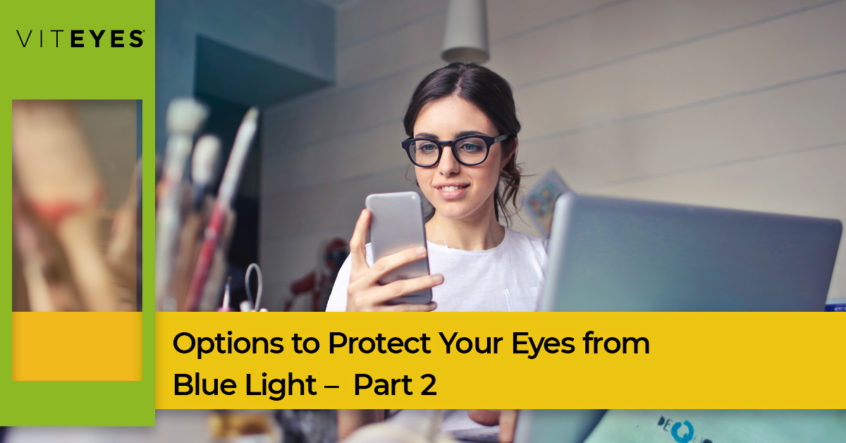Welcome back to our three-part article series on options to protect your eyes from blue light damage. If you haven’t already, we recommend you read part one, which discusses what blue light is and why it may be a concern to you. In today’s post, we will continue the discussion on how to reduce the impact of harmful blue light on your vision when you cannot reduce the amount of time you spend looking at computer screens.
Set up your workstation to support eye health.
Computer screens should be 20 to 30 inches from the eyes, any closer and you may be exposed to even more than necessary harmful artificial blue light. If you can, set your computer screen at an ideal height for you. It should be adjusted so that you look directly at the screen, rather than slightly above or below eye level which only aids in eye strain. Adjust text size to reduce the amount of strain staring at the screen causes.
Low overhead light with natural light balance.
Too little or too much surrounding light can have a significant impact on the effects of blue light exposure and eye strain from looking at a computer screen each day. The light in the office around computers should be a soft white light and include plenty of natural sunlight. Perpendicular window lighting and medium overhead lighting is the ideal lighting situation. Avoid bright overhead lights, low lighting that makes your computer screen the brightest thing in the room, and reduce glare on screens as much as possible.

Reduce the screen lighting.
Most devices and monitors allow you to adjust your brightness settings. It is important to adjust these settings as needed and never simply let it go as you initially set it. Too high of a brightness setting causes unnecessary exposure to harmful blue light, while not enough brightness causes you to strain to see what is on the screen, which may result in eye fatigue. Find a happy medium with the brightness that allows you to see clearly without squinting or straining.
Use blue light filters.
Use blue light filters within the screen itself as well as over the screen filter options to reduce artificial blue light exposure. Programs such as f.lux allow your computer screen to adjust to various lighting throughout your workday and adds a filter to the screen that decreases the amount of artificial blue light that reaches your eyes. Over-the-monitor physical filters are also an option when you are unable to manually adjust settings or download programs onto your work computer.
Take visual breaks.
We can not stress enough how important taking frequent breaks is for your visual, mental, and physical health. We support your desire to have a high work ethic, but taking five minutes each hour to get up from your desk and take a break from staring at your computer screen helps your entire body. Even if you walk to the bathroom or the water fountain each hour, make it a point to break eye contact with your screen, stand, and stretch. While you are at it, take a few deep breaths, completely emptying and filling your lungs, maximizing the amount of oxygen flowing throughout your body. If you don’t do it for your own comfort and sanity, do it for your eye health.
We hope you return to join us for the third, and final portion of this three-part blue light series where we will discuss some non-screen related ways you can decrease the impact of blue light on your eyes. For more information, visit Viteyes® online and discover our Blue Light Defender™ gummies. We are here to support optimal eye health, despite your exposure to harmful blue light.
